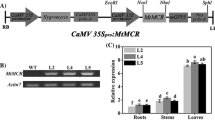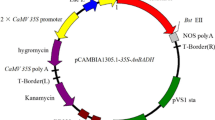Abstract
Glycine betaine (betaine) has the highest cellular osmoprotective efficiency which does not accumulate in most glycophytes. The biosynthetic pathway for betaine in higher plants is derived from the oxidation of low-accumulating metabolite choline that limiting the ability of most plants to produce betaine. Halophilic methanoarchaeon Methanohalophilus portucalensis FDF1T is a model anaerobic methanogen to study the acclimation of water-deficit stresses which de novo synthesize betaine by the stepwise methylation of glycine, catalyzed by glycine sarcosine N-methyltransferase (GSMT) and sarcosine dimethylglycine N-methyltransferase. In this report, genes encoding these betaine biosynthesizing enzymes, Mpgsmt and Mpsdmt, were introduced into Arabidopsis. The homozygous Mpgsmt (G), Mpsdmt (S), and their cross, Mpgsmt and Mpsdmt (G × S) plants showed increased accumulation of betaine. Water loss from detached leaves was slower in G, S, and G × S lines than wild-type (WT). Pot-grown transgenic plants showed better growth than WT after 9 days of withholding water or irrigating with 300 mM NaCl. G, S, G × S lines also maintained higher relative water content and photosystem II activity than WT under salt stress. This suggests heterologously expressed Mpgsmt and Mpsdmt could enhance tolerance to drought and salt stress in Arabidopsis. We also found a twofold increase in quaternary ammonium compounds in salt-stressed leaves of G lines, presumably due to the activation of GSMT activity by high salinity. This study demonstrates that introducing stress-activated enzymes is a way of avoiding the divergence of primary metabolites under normal growing conditions, while also providing protection in stressful environments.






Similar content being viewed by others
Abbreviations
- GSMT:
-
Glycine sarcosine N-methyltransferase
- LC/MS:
-
Liquid chromatograph–mass spectrometry
- QAC:
-
Quaternary ammonium compound
- RWC:
-
Relative water content
- RWL:
-
Rate of water loss
- SDMT:
-
Sarcosine dimethylglycine N-methyltransferase
References
Ahmad R, Kim MD, Back KH, Kim HS, Lee HS, Kwon SY, Murata N, Chung WI, Kwak SS (2008) Stress-induced expression of choline oxidase in potato plant chloroplasts confers enhanced tolerance to oxidative, salt, and drought stresses. Plant Cell Rep 27:687–698
Allakhverdiev SI, Hayashi H, Nishiyama Y, Ivanov AG, Aliev JA, Klimov VV, Murata N, Carpentier R (2003) Glycine betaine protects the D1/D2/Cytb559 complex of photosystem II against photo-induced and heat-induced inactivation. J Plant Physiol 160:41–49
Auton M, Rösgen J, Sinev M, Holthauzen LMF, Bolen DW (2011) Osmolyte effects on protein stability and solubility: a balancing act between backbone and side-chains. Biophys Chem 159:90–99
Ben Hassine A, Ghanem ME, Bouzid S, Lutts S (2008) An inland and a coastal population of the Mediterranean xerohalophyte species Atriplex halimus L. differ in their ability to accumulate proline and glycine betaine in response to salinity and water stress. J Exp Bot 59:1315–1326
Boyer JS (1982) Plant productivity and environment. Science 218:443–448
Chen THH, Murata N (2008) Glycine betaine: an effective protectant against abiotic stress in plants. Trends Plant Sci 13:499–505
Chen THH, Murata N (2011) Glycine betaine protects plants against abiotic stress: mechanisms and biotechnological applications. Plant, Cell Environ 34:1–20
Chen S-Y, Lai M-C, Lai S-J, Lee Y-C (2009) Characterization of osmolyte betaine synthesizing sarcosine dimethylglycine N-methyltransferase from Methanohalophilus portucalensis. Arch Microbiol 191:735–743
Clough SJ, Bent AF (1998) Floral dip: a simplified method for Agrobacterium-mediated transformation of Arabidopsis thaliana. Plant J 16:735–743
Diamant S, Eliahu N, Rosenthal D, Goloubinoff P (2001) Chemical chaperones regulate molecular chaperones in vitro and in cells under combined salt and heat stresses. J Biol Chem 276:39586–39591
Einset J, Nielsen E, Connolly EL, Bones A, Sparstad T, Winge P, Zhu JK (2007) Membrane-trafficking RabA4c involved in the effect of glycine betaine on recovery from chilling stress in Arabidopsis. Physiol Plant 130:511–518
Einset J, Winge P, Bones AM, Connolly EL (2008) The FRO2 ferric reductase is required for glycine betaine’s effect on chilling tolerance in Arabidopsis roots. Physiol Plant 134:334–341
Flowers TJ, Colmer TD (2008) Salinity tolerance in halophytes. New Phytol 179:945–963
Giraud E, Ho LH, Clifton R, Carroll A, Estavillo G, Tan YF, Howell KA, Ivanova A, Pogson BJ, Millar AH, Whelan J (2008) The absence of ALTERNATIVE OXIDASE1a in Arabidopsis results in acute sensitivity to combined light and drought stress. Plant Physiol 147:595–610
Goel D, Singh AK, Yadav V, Babbar SB, Murata N, Bansal KC (2011) Transformation of tomato with a bacterial codA gene enhances tolerance to salt and water stresses. J Plant Physiol 168:1286–1294
Grieve CM, Grattan SR (1983) Rapid assay for determination of water soluble quaternary ammonium compounds. Plant Soil 70:303–307
Hanson AD, May AM, Grumet R, Bode J, Jamieson GC, Rhodes D (1985) Betaine synthesis in chenopods: localization in chloroplasts. Proc Natl Acad Sci USA 82:3678–3682
Harb A, Krishnan A, Ambavaram MM, Pereira A (2010) Molecular and physiological analysis of drought stress in Arabidopsis reveals early responses leading to acclimation in plant growth. Plant Physiol 154:1254–1271
Hasegawa PM, Bressan RA, Zhu JK, Bohnert HJ (2000) Plant cellular and molecular responses to high salinity. Annu Rev Plant Physiol Plant Mol Biol 51:463–499
Huang J, Hirji R, Adam L, Rozwadowski KL, Hammerlindl JK, Keller WA, Selvaraj G (2000) Genetic engineering of glycine betaine production toward enhancing stress tolerance in plants: metabolic limitations. Plant Physiol 122:747–756
Kathuria H, Giri J, Nataraja KN, Murata N, Udayakumar M, Tyagi AK (2009) Glycinebetaine-induced water-stress tolerance in codA-expressing transgenic indica rice is associated with up-regulation of several stress responsive genes. Plant Biotechnol J 7:512–526
Kempf B, Bremer E (1998) Uptake and synthesis of compatible solutes as microbial stress responses to high-osmolality environment. Arch Microbiol 170:319–330
Kimura Y, Kawasaki S, Yoshimoto H, Takegawa K (2010) Glycine betaine biosynthesized from glycine provides an osmolyte for cell growth and spore germination during osmotic stress in Myxococcus xanthus. J Bacteriol 192:1467–1470
Krall JP, Edwards GE (1992) Relationship between photosystem II activity and CO2 fixation in leaves. Physiol Plant 86:180–187
Lai S-J, Lai M-C (2011) Characterization and regulation of the osmolyte betaine synthesizing enzymes GSMT and SDMT from halophilic methanogen Methanohalophilus portucalensis. PLoS ONE 6:e25090
Lai M-C, Ciulla R, Roberts MF, Sowers KR, Gunsalus RP (1995) Extraction and detection of compatible intracellular solutes. In: Sowers KR, Schreier HJ (eds) Archaea, a laboratory manual, methanogens protocols. Cold Spring Harbor Laboratory Press, Cold Spring Harbor, pp 349–368
Lai M-C, Yang D-R, Chuang M-J (1999) Regulatory factors associated with synthesis of the osmolyte glycine betaine in the halophilic methanoarchaeon Methanohalophilus portucalensis. Appl Environ Microbiol 65:828–833
Lai M-C, Wang C–C, Chuang M-J, Wu Y-C, Lee Y-C (2006) Effects of substrate and potassium on the betaine-synthesizing enzyme glycine sarcosine dimethylglycine N-methyltransferase from a halophilic methanoarchaeon Methanohalophilus portucalensis. Res Microbiol 157:948–955
Lu W-D, Chi Z-M, Su C-D (2006) Identification of glycine betaine as compatible solute in Synechococcus sp. WH8102 and characterization of its N-methyltransferase genes involved in betaine synthesis. Arch Microbiol 186:495–506
Ma QQ, Wang W, Li YH, Li DQ, Zou Q (2006) Alleviation of photoinhibition in drought-stressed wheat (Triticum aestivum) by foliar-applied glycine betaine. J Plant Physiol 163:165–175
Naleway JJ (1992) Histochemical, spectrophotometric, and fluorometric GUS substrates. In: Gallagher SR (ed) GUS protocols: using the GUS gene as a reporter of gene expression. Academic Press, San Diego, pp 61–76
Nyyssölä A, Kerovuo J, Kaukinen P, von Weymarn N, Reinikainen T (2000) Extreme halophiles synthesize betaine from glycine by methylation. J Biol Chem 275:22196–22201
Nyyssölä A, Reinikainen T, Leisola M (2001) Characterization of glycine sarcosine N-methyltransferase and sarcosine dimethylglycine N-methyltransferase. Appl Environ Microbiol 67:2044–2050
Park EJ, Jeknić Z, Chen TH, Murata N (2007) The codA transgene for glycinebetaine synthesis increases the size of flowers and fruits in tomato. Plant Biotechnol J 5:422–430
Quan R, Shang M, Zhang H, Zhao Y, Zhang J (2004) Engineering of enhanced glycine betaine synthesis improves drought tolerance in maize. Plant Biotechnol J 2:477–486
Rhodes D, Hanson AD (1993) Quaternary ammonium and tertiary sulfonium compounds in higher-plants. Annu Rev Plant Physiol Plant Mol Biol 44:357–384
Roberts MF (2000) Osmoadaptation and osmoregulation in archaea. Front Biosci 5:796–812
Roberts MF, Lai M-C, Gunsalus RP (1992) Biosynthetic pathways of the osmolytes N-acetyl-β-lysine, β-glutamine, and glycine betaine in Methanohalophilus strain FDF1 suggested by nuclear magnetic resonance analyses. J Bacteriol 174:6688–6693
Roesser M, Muller V (2001) Osmoadaptation in bacteria and archaea: common principles and differences. Environ Microbiol 3:743–754
Rontein D, Basset G, Hanson AD (2002) Metabolic engineering of osmoprotectant accumulation in plants. Metab Eng 4:49–56
Singh M, Sharma NK, Prasad SB, Yadav SS, Narayan G, Rai AK (2013) The freshwater cyanobacterium Anabaena doliolum transformed with ApGSMT-DMT exhibited enhanced salt tolerance and protection to nitrogenase activity, but became halophilic. Microbiology 159:641–648
Sleator RD, Hill C (2001) Bacterial osmoadaptation: the role of osmolytes in bacterial stress and virulence. FEMS Microbiol Rev 26:49–71
Smart RE, Bingham GE (1974) Rapid estimates of relative water content. Plant Physiol 53:258–260
Sulpice R, Tsukaya H, Nonaka H, Mustardy L, Chen THH, Murata N (2003) Enhanced formation of flowers in salt-stressed Arabidopsis after genetic engineering of the synthesis of glycinebetaine. Plant J 36:165–176
Waditee R, Tanaka Y, Aoki K, Hibino T, Jikuya H, Takano J, Takabe T (2003) Isolation and functional characterization of N-methyltransferase that catalyze betaine synthesis from glycine in a halotolerant photosynthetic organism Aphanothece halophytica. J Biol Chem 278:4932–4942
Waditee R, Bhuiyan NH, Rai V, Aoli K, Tanaka Y, Hibino T, Suzuki S, Jagendorf AT, Takabe T, Takabe T (2005) Gene for direct methylation of glycine provides high levels of glycine betaine and abiotic-stress tolerance in Synechococcus and Arabidopsis. Proc Natl Acad Sci USA 102:1318–1323
Waditee-Sirisattha R, Singh M, Kageyama H, Sittipol D, Rai AK, Takabe T (2012) Anabaena sp. PCC7120 transformed with glycine methylation genes from Aphanothece halophytica synthesized glycine betaine showing increased tolerance to salt. Arch Microbiol 194:909–914
Weigel D, Glazebrook J (2002) Arabidopsis: a laboratory manual. Cold Spring Harbor Laboratory Press, Cold Spring Harbor
Wingler A, Lea PJ, Quick WP, Leegood RC (2000) Photorespiration: metabolic pathways and their role in stress protection. Philos Trans R Soc Lond B Biol Sci 55:1517–1529
Wyn Jones RG, Storey R (1981) Betaines. In: Paleg LG, Aspinall D (eds) The physiology and biochemistry of drought resistance in plants. Academic Press, New York, pp 171–204
Yang J, Yen HE (2002) Early salt stress effects on the changes in chemical composition in leaves of ice plant and Arabidopsis. A Fourier transform infrared spectroscopy study. Plant Physiol 130:1032–1042
Acknowledgments
This work has been supported by Grants NSC 100-2321-B-005-005-MY3 from the National Science Council, Taiwan. We are grateful to the Instrument Center, NCHU, Taiwan for assistance with LC/MS analyses.
Author information
Authors and Affiliations
Corresponding authors
Additional information
MC Lai responsible for clone and seed stock requests. HE Yen responsible for contents and experimental procedures in this article.
Electronic supplementary material
Below is the link to the electronic supplementary material.
Rights and permissions
About this article
Cite this article
Lai, SJ., Lai, MC., Lee, RJ. et al. Transgenic Arabidopsis expressing osmolyte glycine betaine synthesizing enzymes from halophilic methanogen promote tolerance to drought and salt stress. Plant Mol Biol 85, 429–441 (2014). https://doi.org/10.1007/s11103-014-0195-8
Received:
Accepted:
Published:
Issue Date:
DOI: https://doi.org/10.1007/s11103-014-0195-8




